Price is now very close to the Elliott wave target at 3,260.
Summary: There is now some bearish divergence with extreme conditions. Minor wave 4 may arrive tomorrow. The short-term target at 3,260 remains the same.
Three large pullbacks or consolidations (fourth waves) during the next 1-2 years are expected: for minor wave 4 (coming soon, possibly tomorrow), then intermediate (4), and then primary 4. Extreme conditions warrant more careful attention to risk management at this time.
The biggest picture, Grand Super Cycle analysis, is here.
Monthly charts were last published here, with video here. There are two further alternate monthly charts here, with video here.
ELLIOTT WAVE COUNTS
The two weekly Elliott wave counts below will be labelled First and Second. They may be about of even probability. When the fifth wave currently unfolding on weekly charts may be complete, then these two wave counts will diverge on the severity of the expected following bear market. To see an illustration of this future divergence monthly charts should be viewed.
FIRST WAVE COUNT
WEEKLY CHART
The basic Elliott wave structure consists of a five wave structure up followed by a three wave structure down (for a bull market). This wave count sees the bull market beginning in March 2009 as an incomplete five wave impulse and now within the last fifth wave, which is labelled cycle wave V. This impulse is best viewed on monthly charts. The weekly chart focusses on the end of it.
Elliott wave is fractal. This fifth wave labelled cycle wave V may end a larger fifth wave labelled Super Cycle wave (V), which may end a larger first wave labelled Grand Super Cycle wave I.
The teal Elliott channel is drawn using Elliott’s first technique about the impulse of Super Cycle wave (V). Draw the first trend line from the end of cycle wave I (off to the left of the chart, the weekly candlestick beginning 30th November 2014) to the end of cycle wave III, then place a parallel copy on the end of cycle wave II. This channel perfectly shows where cycle wave IV ended at support. The strongest portion of cycle wave III, the end of primary wave 3, overshoots the upper edge of the channel. This is a typical look for a third wave and suggests the channel is drawn correctly and the way the impulse is counted is correct.
Within Super Cycle wave (V), cycle wave III is shorter than cycle wave I. A core Elliott wave rule states that a third wave may never be the shortest. For this rule to be met in this instance, cycle wave V may not be longer in length than cycle wave III. This limit is at 3,477.39.
Cycle wave V may subdivide either as an impulse or an ending diagonal. Impulses are much more common. An alternative wave count which considered an ending diagonal has been invalidated. While it is possible a diagonal may become an alternate wave count in coming weeks or months, at this stage the structure does not fit.
At this stage, cycle wave V may take another one to two or so years to complete.
The daily chart below will focus on movement from the end of intermediate wave (2) within primary wave 3.
In historic analysis, two further monthly charts have been published that do not have a limit to upwards movement and are more bullish than this wave count. Members are encouraged to consider those possibilities (links below summary) alongside the wave counts presented on a daily and weekly basis. It is my judgement that the two weekly wave counts published in this analysis have the highest probability, so they shall be the only wave counts published on a daily basis.
Within cycle wave V, primary waves 1 and 2 may be complete. Within primary wave 3, intermediate waves (1) and (2) may be complete. Within the middle of intermediate wave (3), no second wave correction may move beyond its start below 2,855.96.
DAILY CHART
All of primary wave 3, intermediate wave (3) and minor wave 3 may only subdivide as impulses.
Minor wave 3 has passed 1.618 the length of minor wave 1, and within it minute wave v has passed equality in length with minute wave i. Minor wave 3 may end tomorrow.
Minor wave 2 was a sharp deep pullback, so minor wave 4 may be expected to be a very shallow sideways consolidation to exhibit alternation. Minor wave 2 lasted 2 weeks. Minor wave 4 may be about the same duration, or it may be a longer lasting consolidation. Minor wave 4 may end within the price territory of the fourth wave of one lesser degree; minute wave iv has its range from 3,154.26 to 3,070.49.
Minor wave 4 may not move into minor wave 1 price territory below 3,021.99.
Intermediate wave (3) has now moved far enough above the end of intermediate wave (1) to allow intermediate wave (4) to unfold and remain above intermediate wave (1) price territory.
Draw an acceleration channel now about intermediate wave (3): draw the first trend line from the end of minor wave 1 to the last high, then place a parallel copy on the end of minor wave 2. Keep redrawing the channel as price makes new highs. Minor wave 4 may find support at the lower edge of this channel if it is long lasting or deep enough.
HOURLY CHART
It is possible that minor wave 3 may be very close to completion.
This best fit channel is redrawn to contain all upwards movement; it has been slightly adjusted to be as conservative as possible. If this channel is breached, then that may be taken as an indication that minor wave 4 may have arrived. A new low below 3,212.03 may not be a second wave correction within minuette wave (v), so at that stage minuette wave (v) would have to be over; this would add confidence to the idea that minor wave 4 may have arrived.
SECOND WAVE COUNT
WEEKLY CHART
This weekly chart is almost identical to the first weekly chart, with the sole exception being the degree of labelling.
This weekly chart moves the degree of labelling for the impulse beginning in March 2009 all down one degree. This difference is best viewed on monthly charts.
The impulse is still viewed as nearing an end; a fifth wave is still seen as needing to complete higher. This wave count labels it primary wave 5. Primary wave 5 may still need another year to two or so to complete, depending upon how time consuming the corrections within it may be.
Primary wave 5 may be subdividing as an impulse, in the same way that cycle wave V is seen for the first weekly chart.
TECHNICAL ANALYSIS
MONTHLY CHART

Click chart to enlarge. Chart courtesy of StockCharts.com.
There are three large consolidations noted on this chart, in shaded areas. After a breakout from a multi-month consolidation, it is reasonable to expect a multi month bullish move may result.
Note that in each of the first two cases a pullback saw price re-enter the consolidation zone after the breakout, before price then moved up and away. It is possible that may happen again after the last breakout from a consolidation.
This chart very clearly exhibits rising price on declining volume has now persisted for several years. A decline in volume last month, in current market conditions, is not of concern.
On Balance Volume supports the Elliott wave count.
WEEKLY CHART
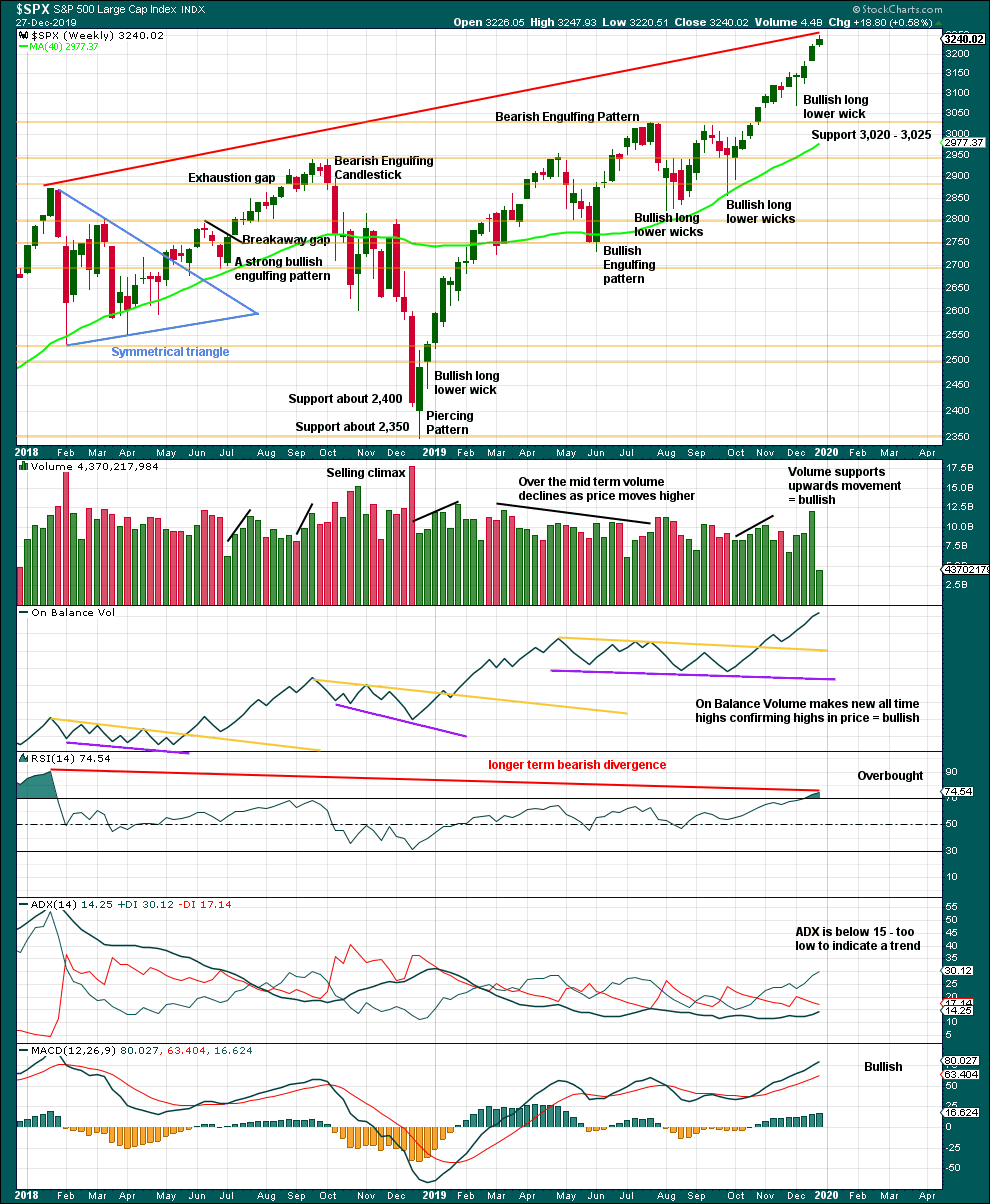
Click chart to enlarge. Chart courtesy of StockCharts.com.
It is very clear that the S&P is in an upwards trend and the bull market is continuing. Price does not move in straight lines; there will be pullbacks and consolidations along the way.
This chart is overall bullish. There are no signs of weakness in upwards movement.
RSI is now overbought. That does not mean upwards movement must end here, because it can continue for several weeks while RSI reaches more extreme. RSI reaching overbought is a warning that conditions are now becoming extreme. A pullback or consolidation will follow and the longer conditions are extreme the closer this will be. However, assume the trend remains the same until proven otherwise. This warning should be heeded by careful attention to risk management.
DAILY CHART
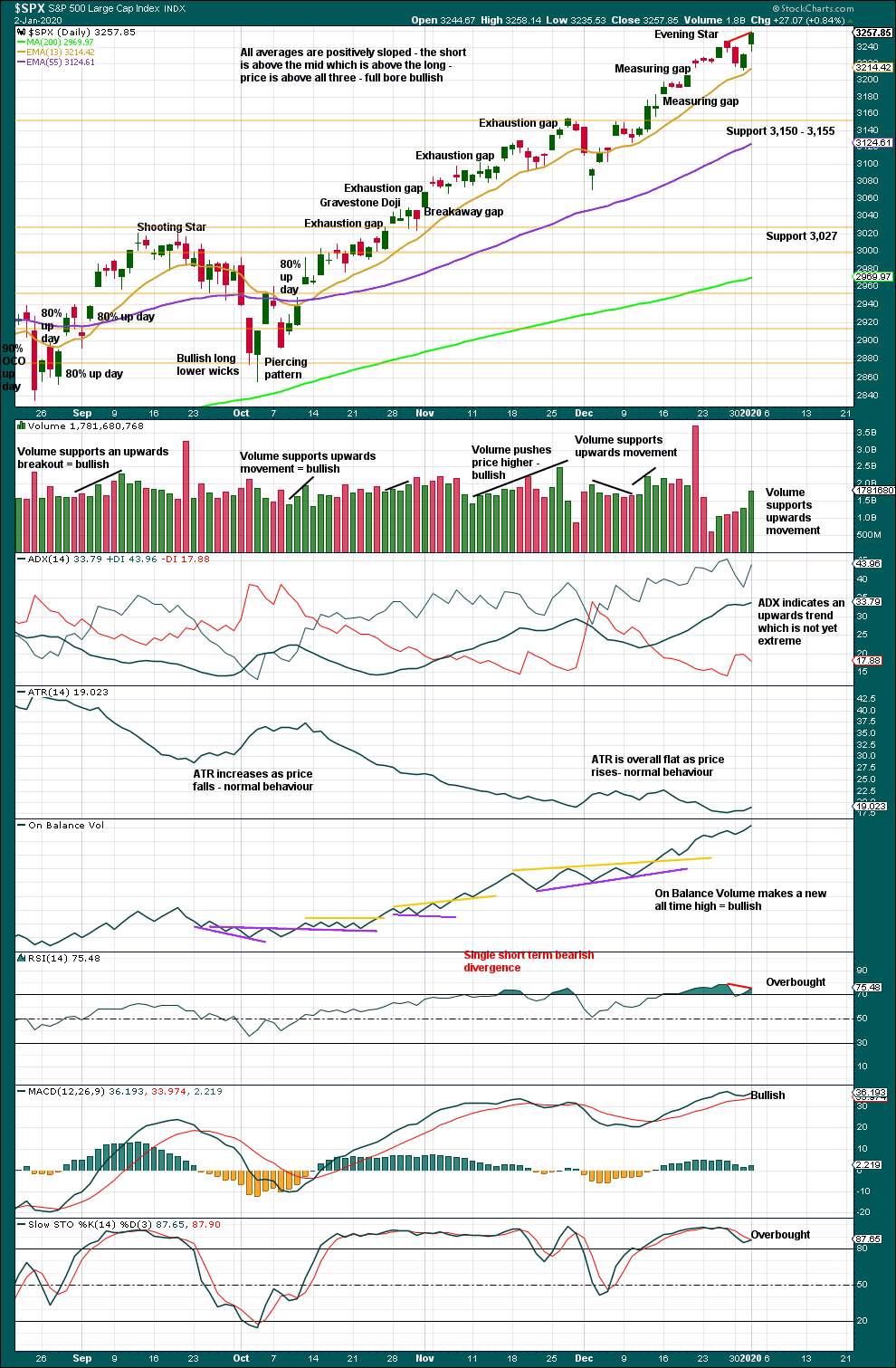
Click chart to enlarge. Chart courtesy of StockCharts.com.
There is an upwards trend in place. There will be corrections along the way.
Like the weekly chart, this chart is bullish.
RSI now exhibits bearish divergence while overbought. This is often (not always) a warning of a pullback or consolidation to develop.
BREADTH – AD LINE
WEEKLY CHART

Click chart to enlarge. Chart courtesy of StockCharts.com. So that colour blind members are included, bearish signals
will be noted with blue and bullish signals with yellow.
Bear markets from the Great Depression and onwards have been preceded by an average minimum of 4 months divergence between price and the AD line with only two exceptions in 1946 and 1976. With the AD line making new all time highs last week, the end of this bull market and the start of a new bear market is very likely a minimum of 4 months away, which is mid March 2020.
In all bear markets in the last 90 years there is some positive correlation (0.6022) between the length of bearish divergence and the depth of the following bear market. No to little divergence is correlated with more shallow bear markets. Longer divergence is correlated with deeper bear markets.
If a bear market does develop here, it comes after no bearish divergence. It would therefore more likely be shallow.
All of small, mid and large caps have made new swing highs above the prior swing high on the 13th of September, and mid caps have now made new all time highs. This upwards movement appears to be mostly driven by large caps, which is a feature of aged bull markets. This bull market at over 10 years duration certainly fits the definition of aged.
Again both price and the AD line have made new all time highs. There is no divergence. Upwards movement has support from rising market breadth.
Large caps all time high: 3,247.93 on 27th December 2019.
Mid caps all time high: 2,071.85 on 27th December 2019.
Small caps all time high: 1,100.58 on 27th August 2018.
DAILY CHART
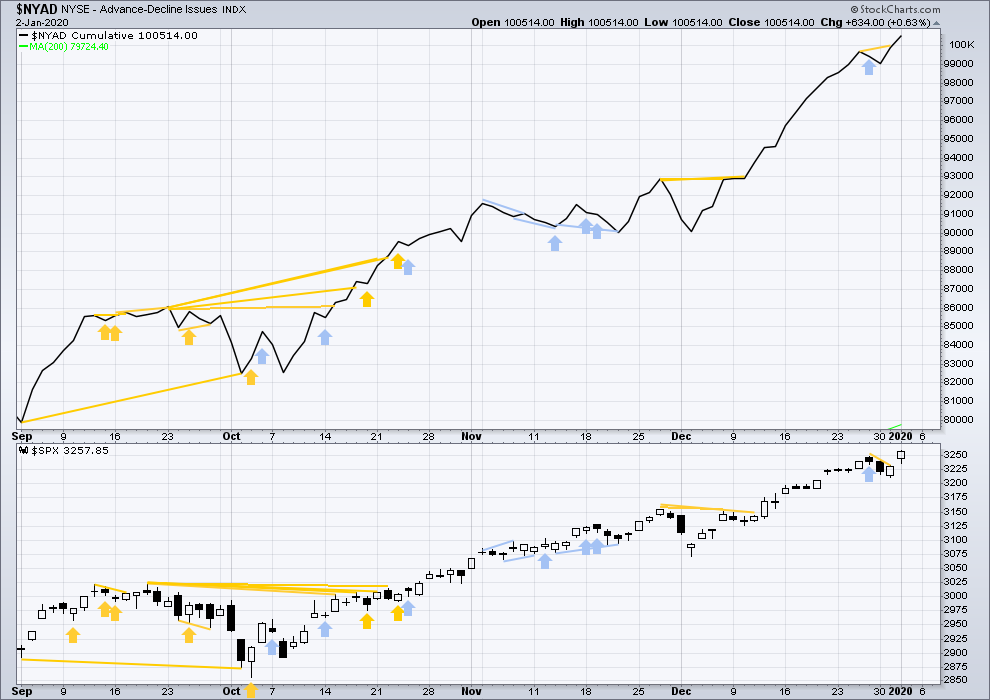
Click chart to enlarge. Chart courtesy of StockCharts.com. So that colour blind members are included, bearish signals
will be noted with blue and bullish signals with yellow.
Breadth should be read as a leading indicator.
Both price and the AD line make new all time highs. Upwards movement has support from rising market breadth. This is bullish.
VOLATILITY – INVERTED VIX CHART
WEEKLY CHART
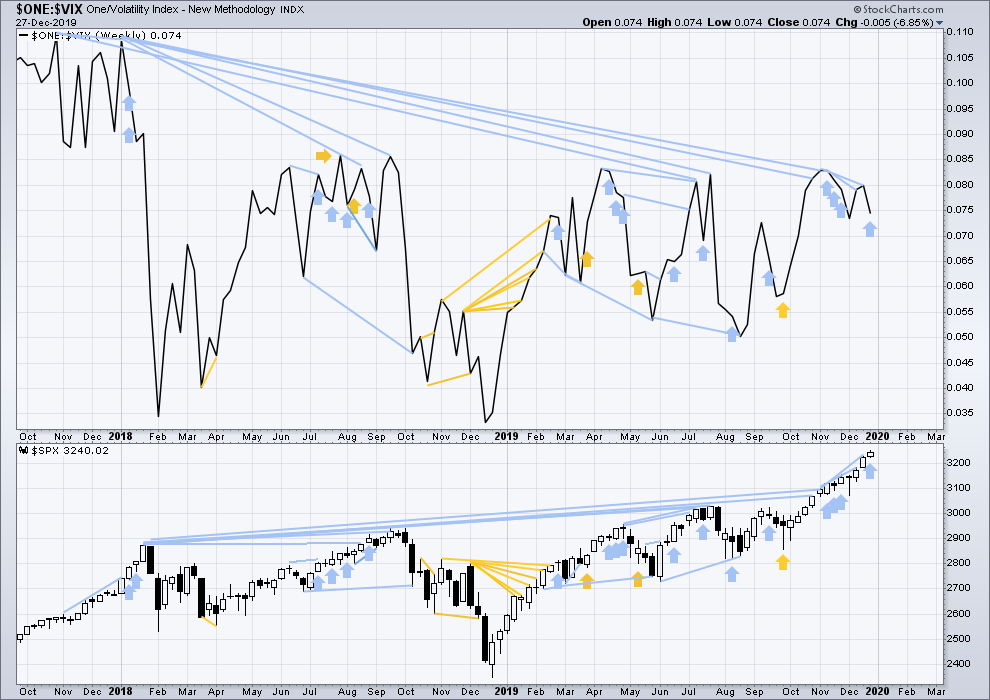
Click chart to enlarge. Chart courtesy of StockCharts.com. So that colour blind members are included, bearish signals
will be noted with blue and bullish signals with yellow.
The all time high for inverted VIX was on 30th October 2017. There is now over two years of bearish divergence between price and inverted VIX.
The rise in price is not coming with a normal corresponding decline in VIX; VIX remains elevated. This long-term divergence is bearish and may yet develop further as the bull market matures.
This divergence may be an early warning, a part of the process of a top developing that may take years. It may is clearly not useful in timing a trend change from bull to a fully fledged bear market.
Last week price has moved higher, but inverted VIX has moved lower. This single week of bearish divergence may be a warning that minor wave 4 may have arrived, or it may yet develop further before minor wave 4 arrives.
DAILY CHART

Click chart to enlarge. Chart courtesy of StockCharts.com. So that colour blind members are included, bearish signals
will be noted with blue and bullish signals with yellow.
Both price and inverted VIX have moved higher today, but all of short, mid and long-term bearish divergences between price and inverted VIX remain.
DOW THEORY
Dow Theory confirmed a bear market in December 2018. This does not necessarily mean a bear market at Grand Super Cycle degree though; Dow Theory makes no comment on Elliott wave counts. On the 25th of August 2015 Dow Theory also confirmed a bear market. The Elliott wave count sees that as part of cycle wave II. After Dow Theory confirmation of a bear market in August 2015, price went on to make new all time highs and the bull market continued.
DJIA: 23,344.52 – a close on the 19th of December at 23,284.97 confirms a bear market.
DJT: 9,806.79 – price has closed below this point on the 13th of December.
S&P500: 2,532.69 – a close on the 19th of December at 2,506.96 provides support to a bear market conclusion.
Nasdaq: 6,630.67 – a close on the 19th of December at 6,618.86 provides support to a bear market conclusion.
With all the indices having moved higher following a Dow Theory bear market confirmation, Dow Theory would confirm a bull market if the following highs are made:
DJIA: 26,951.81 – a close above this point has been made on the 3rd of July 2019.
DJT: 11,623.58 – to date DJT has failed to confirm an ongoing bull market.
S&P500: 2,940.91 – a close above this point was made on the 29th of April 2019.
Nasdaq: 8,133.30 – a close above this point was made on the 26th of April 2019.
Published @ 08:09 p.m. EST.
—
Careful risk management protects your trading account(s).
Follow my two Golden Rules:
1. Always trade with stops.
2. Risk only 1-5% of equity on any one trade.
—
New updates to this analysis are in bold.

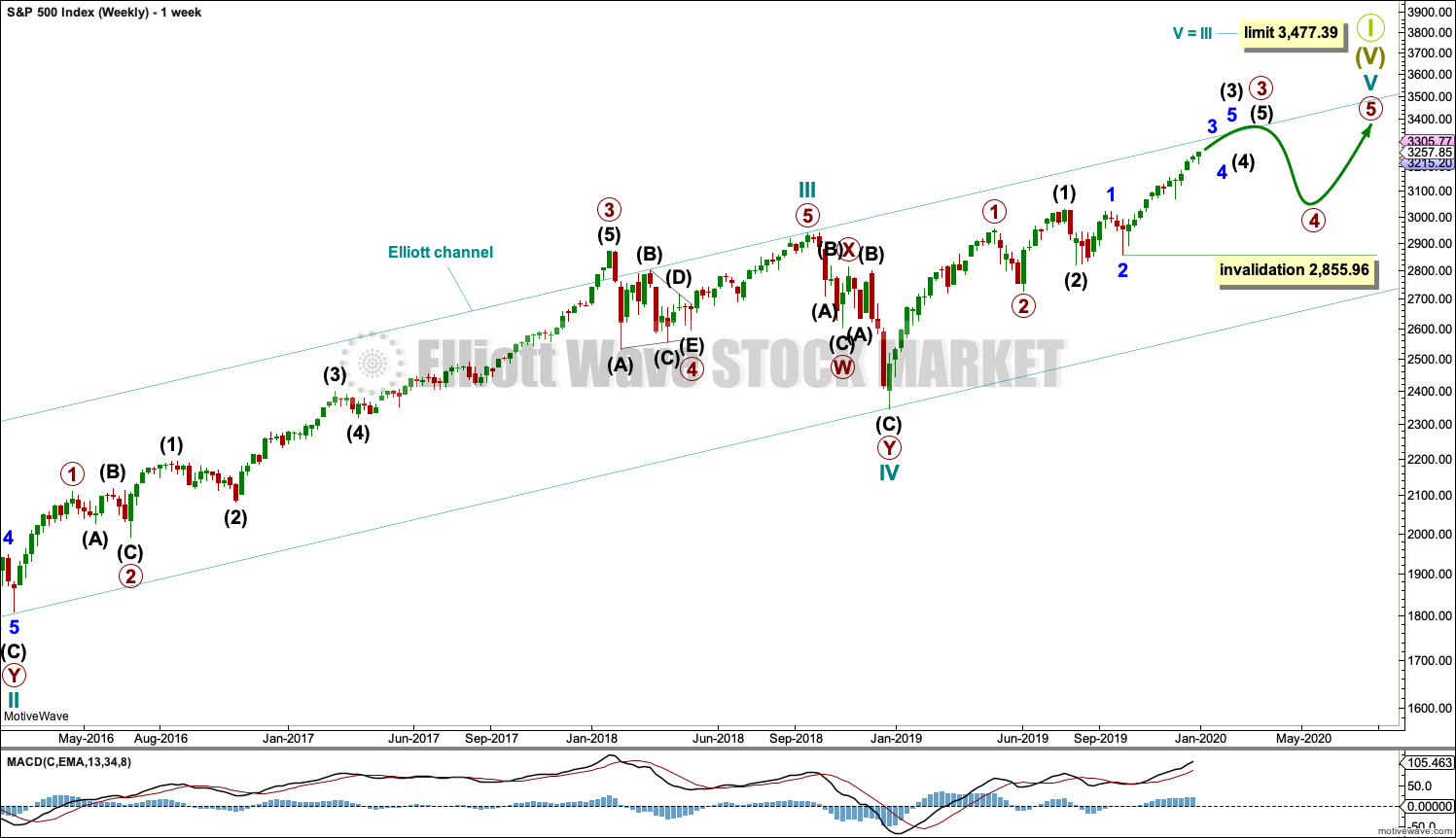
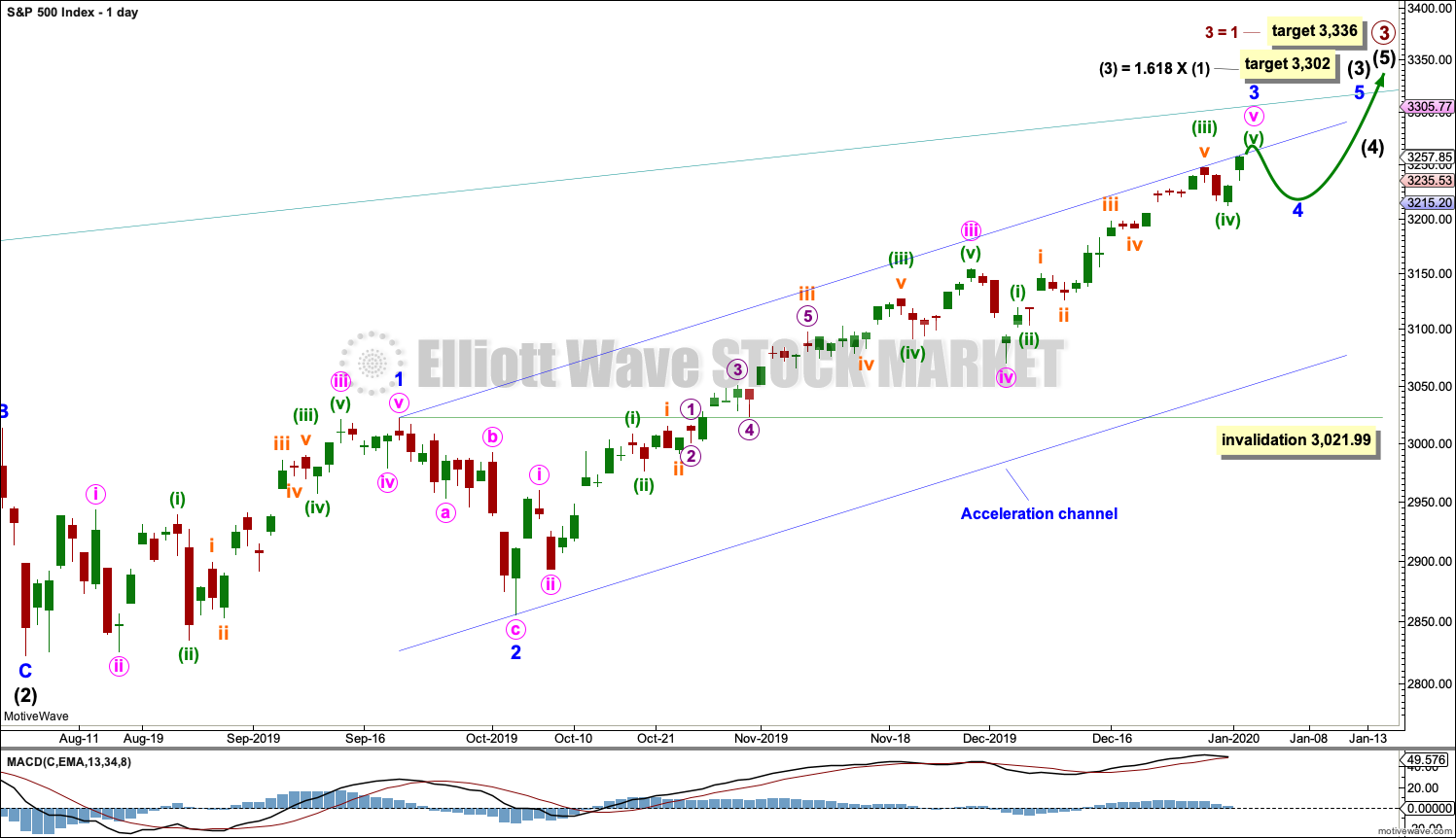
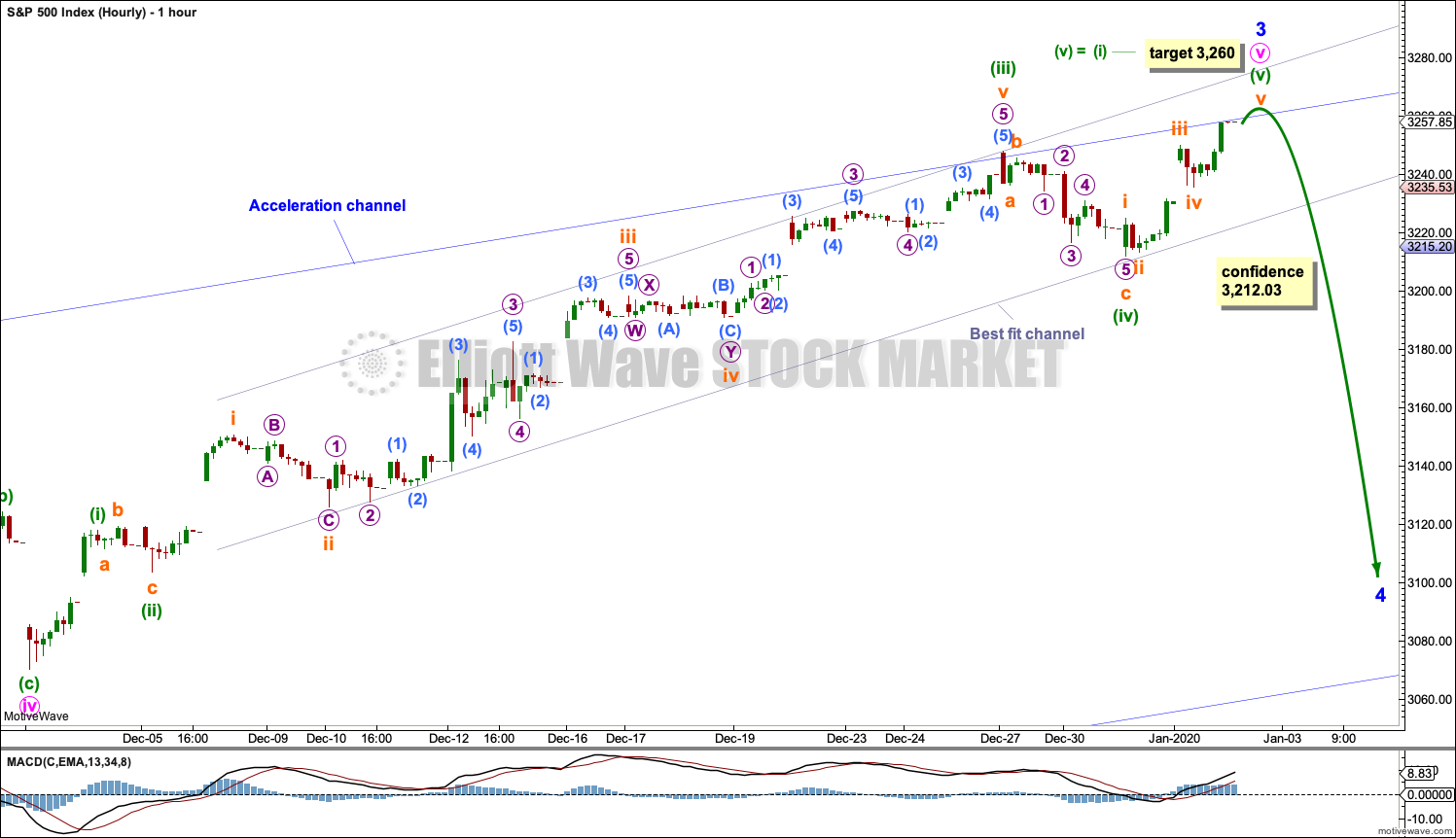
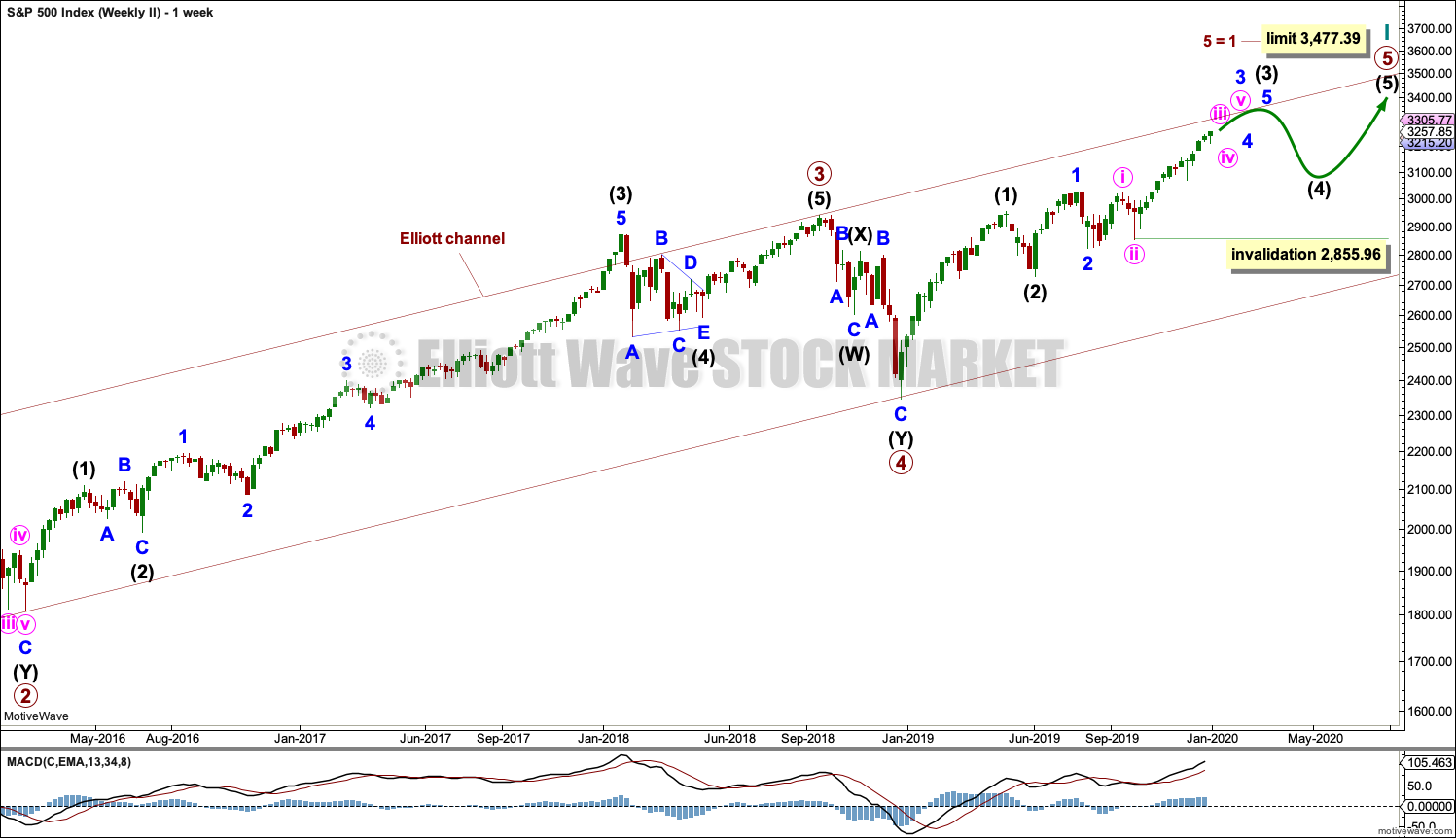
Hourly chart update
It’s interesting that price has bounced up perfectly off the lower edge of this best fit channel. That is a concern for this main wave count.
I’ll have an alternate today which moves the degree of labelling within minuette (v) down one degree and looks at the possibility it may continue.
The important invalidation / confidence point will remain the same at 3,212.03
RUT is doing the same thing, with a small overshoot.
Where’s the rabbit to hold our hand through a vicious kick-back rally when we need him? You’d think he’d just retired to a life of carrots and close personal friends. Tell us this going to turn back down, Verne…
Do I hear 3250 as a high today? (the 78.6% on SPX). Breaking up through that is going to alert my defensive systems.
I just put on my shorts and ate a carrot….
Don’t bogart those carrots, my friend!! Pass one over to me…
Watch Lara’s invalidation point of 3212.03 as i t correlates quite closely with my near term line-in-the-sand of round number 3200…
Give a rabbit a carrot and he will eat for a day, teach him to trade and he will eat for a lifetime…
/ES (5 minute, with overnight data), potentially turning back down now at the 61.8% retrace level, after an initial i down, ii up (or a down, b up).
Thanks for this, Kevin. I never know quite what to make of ES overnight data. So little volume. Yet the markets clearly view it as significant.
I’ve made a few nice profitable trades on the night shift, but not much later than 8PM central time. Big moves in the early morning hours are so disconnected from the previous day that it’s hard to know what to think unless there is some big news event overnight.
I’d appreciate anyone else’s thoughts…
If it’s a B wave, can it potentially retrace above ATH or if it does, does it invalidate minor 4 start?
As an expanding flat it could move up and past the ATH as a 3 wave move. Then a 5 wave C down (and down and down and down and down it might go…or not).
But first order would be a perspective the the minor 3 would is continuing, I think, should that happen.
It’s too early for that. It needs to make a five down on the hourly chart first. Then a three up, then another five down.
Once we can see a zigzag down, then a new ATH could be wave B
A put butterfly in SPX targeting just about the complete spread of the minute iv range now costs $1.50, for a Jan 17 3150/3110/3070 ‘fly. At 4 such ‘flys, max win is about $14,000. Max loss is -$600. I like it. This is leveraging our EW knowledge to the max, in my view.
U.S. air strike in Iraq can be the start of minor wave 4. We’ll see.
Wow, target of 3260 was reached. Do they make news based on EW? I wonder if EW depends on news or the other way around:)
Yes, overnight markets are falling pretty hard. Not confirming but strongly indicating this big wave 3 is finally complete. /RTY and /ES and /YM.
Re: iraq air strike was a few days ago now…I think this market “is ready” regardless of news. It’s profit taking time…
Hi Kevin, so do you agree with Lara that once hourly price closes below 3012 it would be confirmed to be minor wave 4?
I never disagree with Lara. That path leads to the dark side….(yea, I’ve been watching the Star Wars movies with my disney+ subscription, sorry!).
Sometimes I have an alternative view or model that I think has some probability of working out that I share, but that’s not a disagreement, that’s an alternative model.
Oh yea if prices close down there “it’s on” (with very high probability). And I’ll be adding to my shorts (probably before that even happens, actually, but maybe yet more after too!).
Oops, I wasn’t aware of the most recent assassination via drone strike of a top Iranian Quds commander. Yea, that’s probably spooked the market!! And I see oil has surged anticipating more mid-east issues and potential disruption of oil flows.
By the way, the kick-back rally here this morning almost reached the 61.8% retrace level of the swing down (on /ES), and appears to be turning back down now. Looks like an initial A down, B up, and C down starting (or i down, ii up, and iii down of an A, starting).
Bingo!